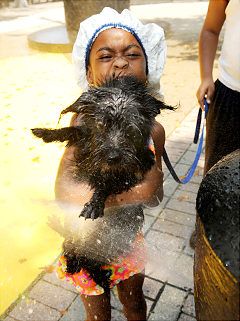(3 pm. – promoted by ek hornbeck)
 As many here in the Northeast already know, it’s hot. Temperature in many places are in triple digits, coupled with high humidity and stagnant air. It can be life threatening. The entire region is under a heat alert and many cities have poor air quality alerts.
As many here in the Northeast already know, it’s hot. Temperature in many places are in triple digits, coupled with high humidity and stagnant air. It can be life threatening. The entire region is under a heat alert and many cities have poor air quality alerts.
Most people know to wear cool, loose clothing, drink plenty of non-alcoholic, decaffeinated beverages and stay in the shade, air conditioning or a room with windows open and fans. Take cool showers. You should also limit exercise to very early morning hours. Although in this heat with temperatures already pushing 90 at 7 AM, it might be a good idea to forgo exercise altogether, especially for those on medication for hypertension, cardiac disease or diabetes. Many cities have cooling centers for those without air conditioning and places, like NYC, are extending the hours of municipal pools and beaches keeping lifeguards on duty until dusk.
If you have pets, keep their water bowls full with clean fresh water, keep them indoors or provide an airy, shaded place. Limit their exercise, as well, to early morning and after sundown.
Relief is expected on Friday when a cold front pushes through bringing thunder showers and cooler temperatures for the weekend. Meanwhile stay cool and wet, inside and out.
These are some of the guidelines from the CDC for Heat Related Emergencies:
There are two types of illness that are heat related: Heat Exhaustion and Heat Stroke. Heat Exhaustion leads to Heat Stroke if not treated. Heat Stroke is life threatening and in these temperatures can develop rapidly.
The symptoms of Heat Exhaustion include:
* Heavy sweating
* Paleness
* Muscle cramps
* Tiredness
* Weakness
* Dizziness
* Headache
* Nausea or vomiting
* FaintingThe skin will be cool and moist, pulse rate will be rapid, breathing is fast and shallow. If symptoms last longer than an hour, seek medical attention.
Some of the symptoms for Heat Stroke are:
* An extremely high body temperature (above 103°F)
* Red, hot, and dry skin (no sweating)
* Rapid, strong pulse
* Throbbing headache
* Dizziness
* Nausea
* Confusion
* Unconsciousness5. If you see any of these signs, you may be dealing with a life-threatening emergency. Have someone call for immediate medical assistance while you begin cooling the victim. Do the following:
* Get the victim to a shady area.
* Cool the victim rapidly, using whatever methods you can. For example, immerse the victim in a tub of cool water; place the person in a cool shower; spray the victim with cool water from a garden hose; sponge the person with cool water; or if the humidity is low, wrap the victim in a cool, wet sheet and fan him or her vigorously.
* Monitor body temperature and continue cooling efforts until the body temperature drops to 101-102°F.
* If emergency medical personnel are delayed, call the hospital emergency room for further instructions.
* Do not give the victim alcohol to drink.
* Get medical assistance as soon as possible.

1 comments
Author